Leadership and Management Theories Application in Organisations
VerifiedAdded on 2024/06/28
|23
|4988
|391
Report
AI Summary
This report defines and compares the roles and characteristics of leaders and managers within organisations, using Admiral Group as an example. It examines how these roles apply in different situational contexts, referencing Fayol's five functions of a manager. The report also applies different leadership theories and models, including situational leadership, systems leadership, and contingency theory, with examples like Jack Stahl's leadership at Coca-Cola and Fiedler's Contingency Model. The analysis covers diagnosing, adapting, communicating, and advancing as key elements of situational leadership, contrasting it with Fiedler's view on the immutability of leadership styles. Rolls Royce Plc. is discussed to explain coordination between different departments.
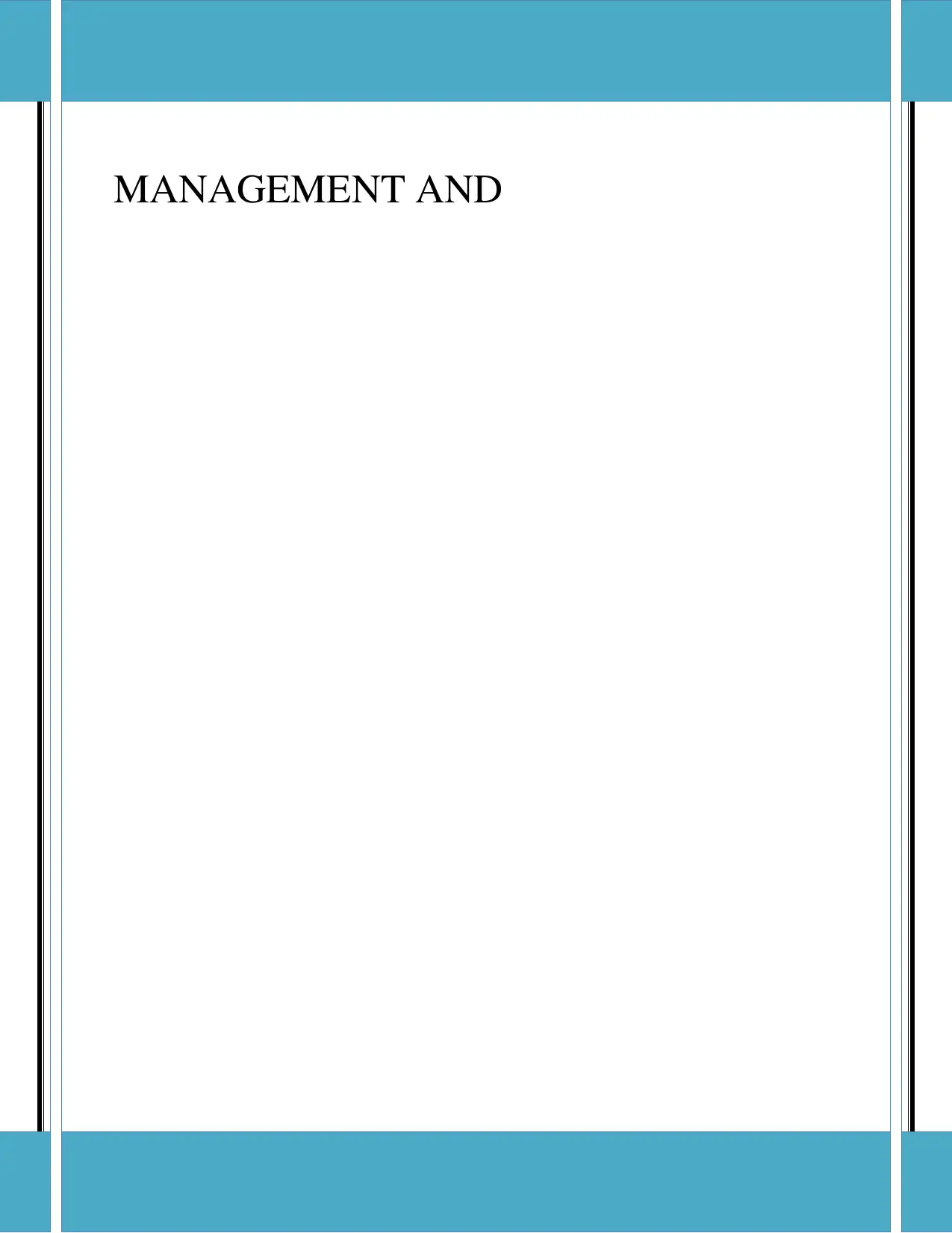
Paraphrase This Document
Need a fresh take? Get an instant paraphrase of this document with our AI Paraphraser
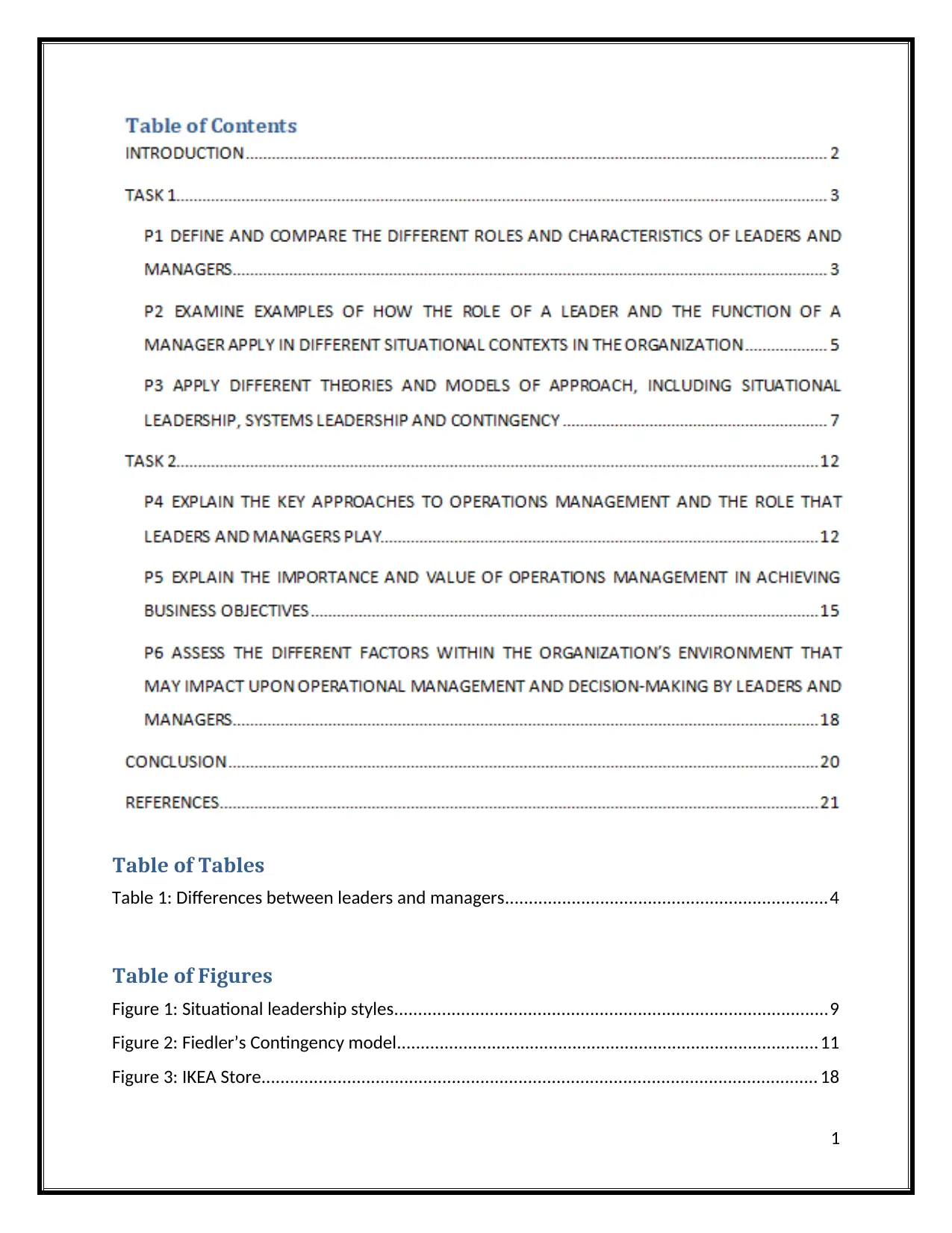
Table of Tables
Table 1: Differences between leaders and managers....................................................................4
Table of Figures
Figure 1: Situational leadership styles...........................................................................................9
Figure 2: Fiedler’s Contingency model.........................................................................................11
Figure 3: IKEA Store..................................................................................................................... 18
1
Table 1: Differences between leaders and managers....................................................................4
Table of Figures
Figure 1: Situational leadership styles...........................................................................................9
Figure 2: Fiedler’s Contingency model.........................................................................................11
Figure 3: IKEA Store..................................................................................................................... 18
1
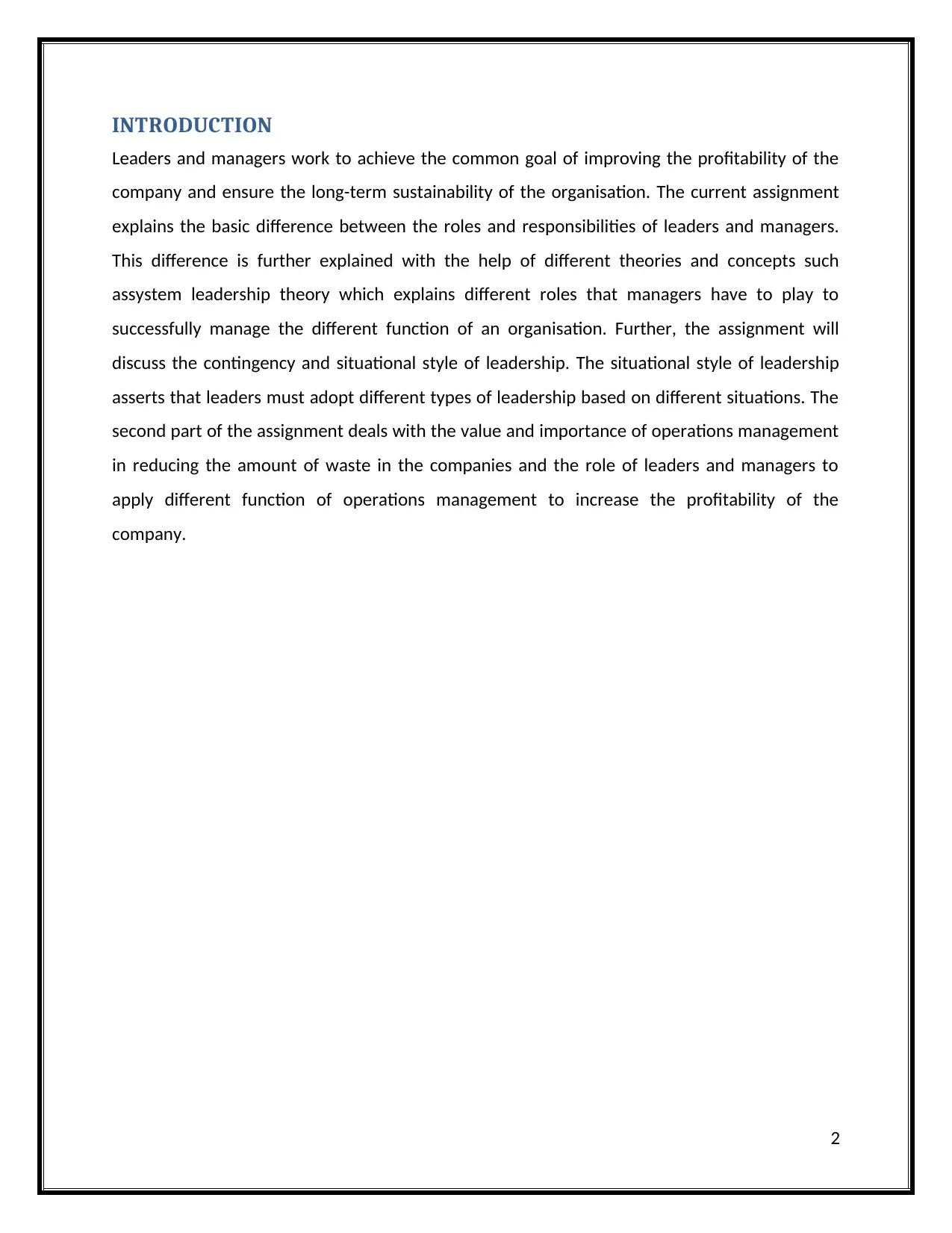
INTRODUCTION
Leaders and managers work to achieve the common goal of improving the profitability of the
company and ensure the long-term sustainability of the organisation. The current assignment
explains the basic difference between the roles and responsibilities of leaders and managers.
This difference is further explained with the help of different theories and concepts such
assystem leadership theory which explains different roles that managers have to play to
successfully manage the different function of an organisation. Further, the assignment will
discuss the contingency and situational style of leadership. The situational style of leadership
asserts that leaders must adopt different types of leadership based on different situations. The
second part of the assignment deals with the value and importance of operations management
in reducing the amount of waste in the companies and the role of leaders and managers to
apply different function of operations management to increase the profitability of the
company.
2
Leaders and managers work to achieve the common goal of improving the profitability of the
company and ensure the long-term sustainability of the organisation. The current assignment
explains the basic difference between the roles and responsibilities of leaders and managers.
This difference is further explained with the help of different theories and concepts such
assystem leadership theory which explains different roles that managers have to play to
successfully manage the different function of an organisation. Further, the assignment will
discuss the contingency and situational style of leadership. The situational style of leadership
asserts that leaders must adopt different types of leadership based on different situations. The
second part of the assignment deals with the value and importance of operations management
in reducing the amount of waste in the companies and the role of leaders and managers to
apply different function of operations management to increase the profitability of the
company.
2
⊘ This is a preview!⊘
Do you want full access?
Subscribe today to unlock all pages.

Trusted by 1+ million students worldwide
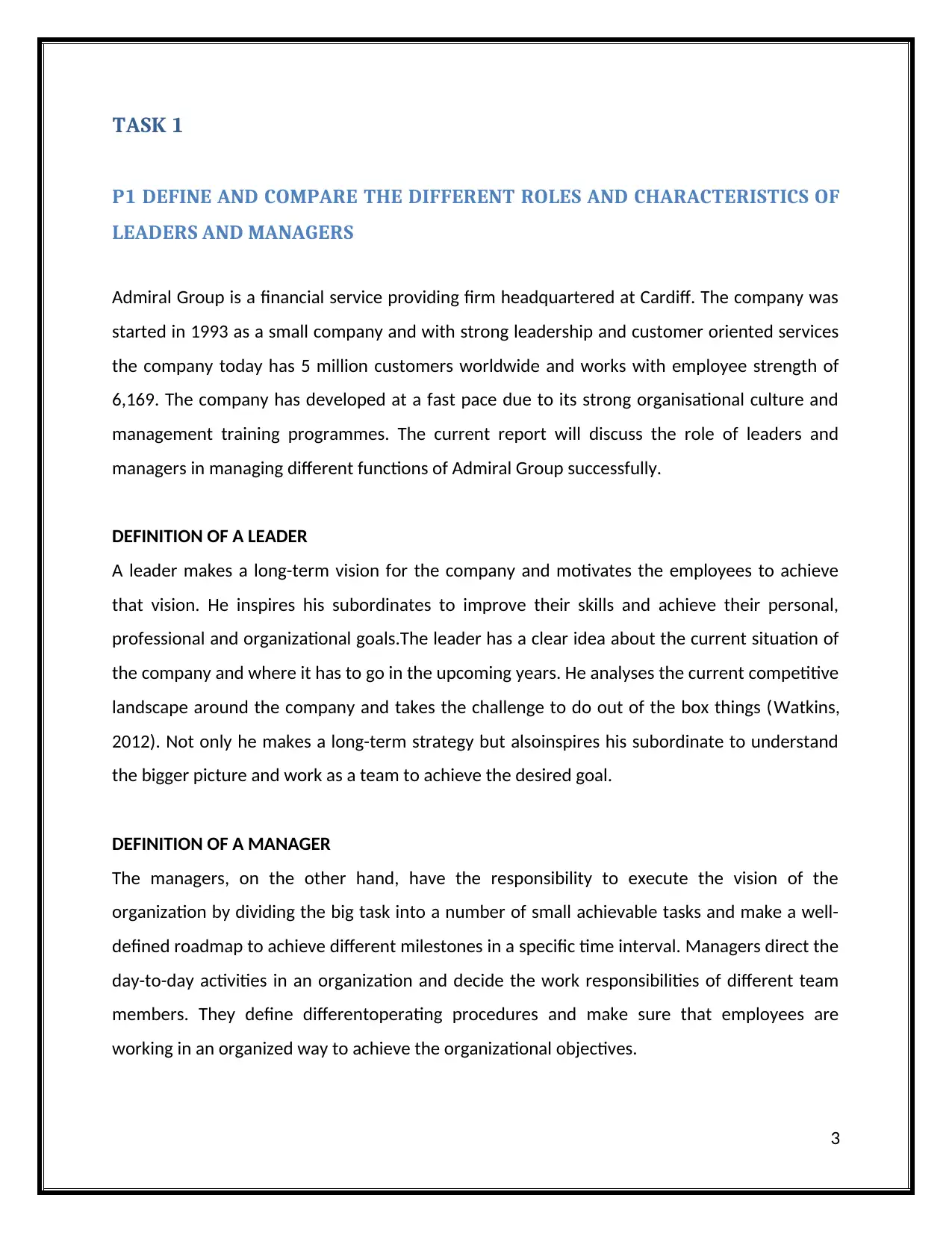
TASK 1
P1 DEFINE AND COMPARE THE DIFFERENT ROLES AND CHARACTERISTICS OF
LEADERS AND MANAGERS
Admiral Group is a financial service providing firm headquartered at Cardiff. The company was
started in 1993 as a small company and with strong leadership and customer oriented services
the company today has 5 million customers worldwide and works with employee strength of
6,169. The company has developed at a fast pace due to its strong organisational culture and
management training programmes. The current report will discuss the role of leaders and
managers in managing different functions of Admiral Group successfully.
DEFINITION OF A LEADER
A leader makes a long-term vision for the company and motivates the employees to achieve
that vision. He inspires his subordinates to improve their skills and achieve their personal,
professional and organizational goals.The leader has a clear idea about the current situation of
the company and where it has to go in the upcoming years. He analyses the current competitive
landscape around the company and takes the challenge to do out of the box things (Watkins,
2012). Not only he makes a long-term strategy but alsoinspires his subordinate to understand
the bigger picture and work as a team to achieve the desired goal.
DEFINITION OF A MANAGER
The managers, on the other hand, have the responsibility to execute the vision of the
organization by dividing the big task into a number of small achievable tasks and make a well-
defined roadmap to achieve different milestones in a specific time interval. Managers direct the
day-to-day activities in an organization and decide the work responsibilities of different team
members. They define differentoperating procedures and make sure that employees are
working in an organized way to achieve the organizational objectives.
3
P1 DEFINE AND COMPARE THE DIFFERENT ROLES AND CHARACTERISTICS OF
LEADERS AND MANAGERS
Admiral Group is a financial service providing firm headquartered at Cardiff. The company was
started in 1993 as a small company and with strong leadership and customer oriented services
the company today has 5 million customers worldwide and works with employee strength of
6,169. The company has developed at a fast pace due to its strong organisational culture and
management training programmes. The current report will discuss the role of leaders and
managers in managing different functions of Admiral Group successfully.
DEFINITION OF A LEADER
A leader makes a long-term vision for the company and motivates the employees to achieve
that vision. He inspires his subordinates to improve their skills and achieve their personal,
professional and organizational goals.The leader has a clear idea about the current situation of
the company and where it has to go in the upcoming years. He analyses the current competitive
landscape around the company and takes the challenge to do out of the box things (Watkins,
2012). Not only he makes a long-term strategy but alsoinspires his subordinate to understand
the bigger picture and work as a team to achieve the desired goal.
DEFINITION OF A MANAGER
The managers, on the other hand, have the responsibility to execute the vision of the
organization by dividing the big task into a number of small achievable tasks and make a well-
defined roadmap to achieve different milestones in a specific time interval. Managers direct the
day-to-day activities in an organization and decide the work responsibilities of different team
members. They define differentoperating procedures and make sure that employees are
working in an organized way to achieve the organizational objectives.
3
Paraphrase This Document
Need a fresh take? Get an instant paraphrase of this document with our AI Paraphraser
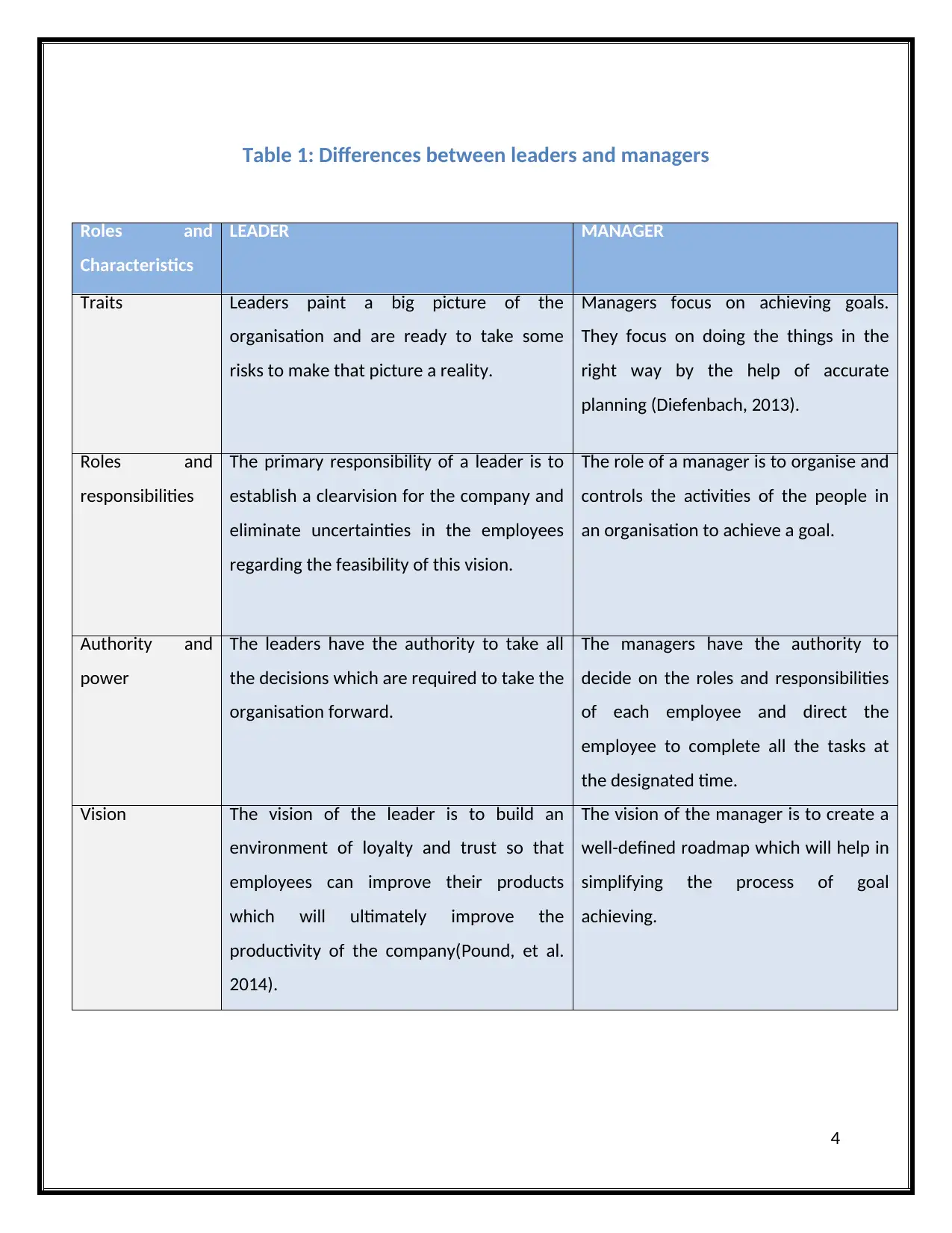
Table 1: Differences between leaders and managers
Roles and
Characteristics
LEADER MANAGER
Traits Leaders paint a big picture of the
organisation and are ready to take some
risks to make that picture a reality.
Managers focus on achieving goals.
They focus on doing the things in the
right way by the help of accurate
planning (Diefenbach, 2013).
Roles and
responsibilities
The primary responsibility of a leader is to
establish a clearvision for the company and
eliminate uncertainties in the employees
regarding the feasibility of this vision.
The role of a manager is to organise and
controls the activities of the people in
an organisation to achieve a goal.
Authority and
power
The leaders have the authority to take all
the decisions which are required to take the
organisation forward.
The managers have the authority to
decide on the roles and responsibilities
of each employee and direct the
employee to complete all the tasks at
the designated time.
Vision The vision of the leader is to build an
environment of loyalty and trust so that
employees can improve their products
which will ultimately improve the
productivity of the company(Pound, et al.
2014).
The vision of the manager is to create a
well-defined roadmap which will help in
simplifying the process of goal
achieving.
4
Roles and
Characteristics
LEADER MANAGER
Traits Leaders paint a big picture of the
organisation and are ready to take some
risks to make that picture a reality.
Managers focus on achieving goals.
They focus on doing the things in the
right way by the help of accurate
planning (Diefenbach, 2013).
Roles and
responsibilities
The primary responsibility of a leader is to
establish a clearvision for the company and
eliminate uncertainties in the employees
regarding the feasibility of this vision.
The role of a manager is to organise and
controls the activities of the people in
an organisation to achieve a goal.
Authority and
power
The leaders have the authority to take all
the decisions which are required to take the
organisation forward.
The managers have the authority to
decide on the roles and responsibilities
of each employee and direct the
employee to complete all the tasks at
the designated time.
Vision The vision of the leader is to build an
environment of loyalty and trust so that
employees can improve their products
which will ultimately improve the
productivity of the company(Pound, et al.
2014).
The vision of the manager is to create a
well-defined roadmap which will help in
simplifying the process of goal
achieving.
4
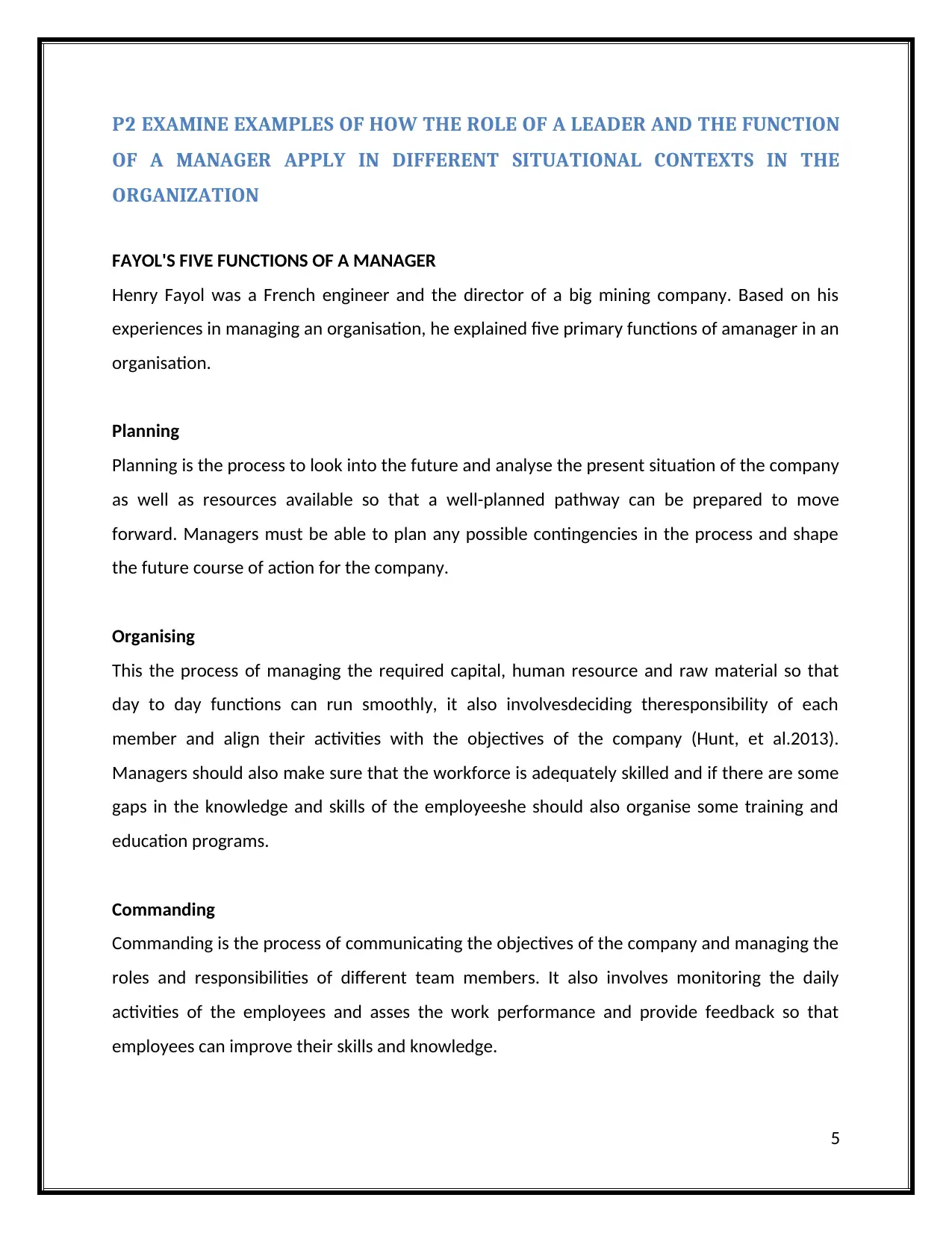
P2 EXAMINE EXAMPLES OF HOW THE ROLE OF A LEADER AND THE FUNCTION
OF A MANAGER APPLY IN DIFFERENT SITUATIONAL CONTEXTS IN THE
ORGANIZATION
FAYOL'S FIVE FUNCTIONS OF A MANAGER
Henry Fayol was a French engineer and the director of a big mining company. Based on his
experiences in managing an organisation, he explained five primary functions of amanager in an
organisation.
Planning
Planning is the process to look into the future and analyse the present situation of the company
as well as resources available so that a well-planned pathway can be prepared to move
forward. Managers must be able to plan any possible contingencies in the process and shape
the future course of action for the company.
Organising
This the process of managing the required capital, human resource and raw material so that
day to day functions can run smoothly, it also involvesdeciding theresponsibility of each
member and align their activities with the objectives of the company (Hunt, et al.2013).
Managers should also make sure that the workforce is adequately skilled and if there are some
gaps in the knowledge and skills of the employeeshe should also organise some training and
education programs.
Commanding
Commanding is the process of communicating the objectives of the company and managing the
roles and responsibilities of different team members. It also involves monitoring the daily
activities of the employees and asses the work performance and provide feedback so that
employees can improve their skills and knowledge.
5
OF A MANAGER APPLY IN DIFFERENT SITUATIONAL CONTEXTS IN THE
ORGANIZATION
FAYOL'S FIVE FUNCTIONS OF A MANAGER
Henry Fayol was a French engineer and the director of a big mining company. Based on his
experiences in managing an organisation, he explained five primary functions of amanager in an
organisation.
Planning
Planning is the process to look into the future and analyse the present situation of the company
as well as resources available so that a well-planned pathway can be prepared to move
forward. Managers must be able to plan any possible contingencies in the process and shape
the future course of action for the company.
Organising
This the process of managing the required capital, human resource and raw material so that
day to day functions can run smoothly, it also involvesdeciding theresponsibility of each
member and align their activities with the objectives of the company (Hunt, et al.2013).
Managers should also make sure that the workforce is adequately skilled and if there are some
gaps in the knowledge and skills of the employeeshe should also organise some training and
education programs.
Commanding
Commanding is the process of communicating the objectives of the company and managing the
roles and responsibilities of different team members. It also involves monitoring the daily
activities of the employees and asses the work performance and provide feedback so that
employees can improve their skills and knowledge.
5
⊘ This is a preview!⊘
Do you want full access?
Subscribe today to unlock all pages.

Trusted by 1+ million students worldwide
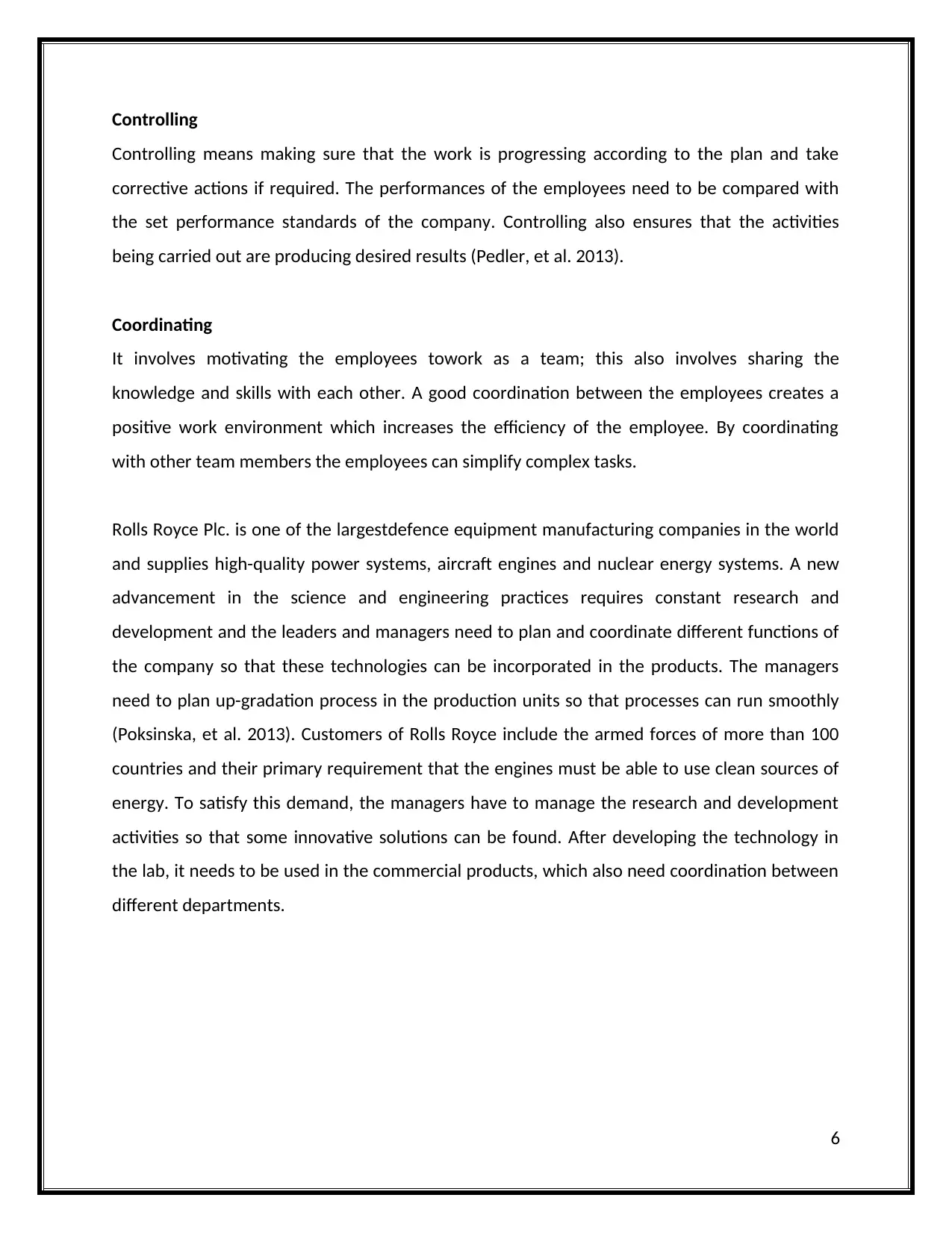
Controlling
Controlling means making sure that the work is progressing according to the plan and take
corrective actions if required. The performances of the employees need to be compared with
the set performance standards of the company. Controlling also ensures that the activities
being carried out are producing desired results (Pedler, et al. 2013).
Coordinating
It involves motivating the employees towork as a team; this also involves sharing the
knowledge and skills with each other. A good coordination between the employees creates a
positive work environment which increases the efficiency of the employee. By coordinating
with other team members the employees can simplify complex tasks.
Rolls Royce Plc. is one of the largestdefence equipment manufacturing companies in the world
and supplies high-quality power systems, aircraft engines and nuclear energy systems. A new
advancement in the science and engineering practices requires constant research and
development and the leaders and managers need to plan and coordinate different functions of
the company so that these technologies can be incorporated in the products. The managers
need to plan up-gradation process in the production units so that processes can run smoothly
(Poksinska, et al. 2013). Customers of Rolls Royce include the armed forces of more than 100
countries and their primary requirement that the engines must be able to use clean sources of
energy. To satisfy this demand, the managers have to manage the research and development
activities so that some innovative solutions can be found. After developing the technology in
the lab, it needs to be used in the commercial products, which also need coordination between
different departments.
6
Controlling means making sure that the work is progressing according to the plan and take
corrective actions if required. The performances of the employees need to be compared with
the set performance standards of the company. Controlling also ensures that the activities
being carried out are producing desired results (Pedler, et al. 2013).
Coordinating
It involves motivating the employees towork as a team; this also involves sharing the
knowledge and skills with each other. A good coordination between the employees creates a
positive work environment which increases the efficiency of the employee. By coordinating
with other team members the employees can simplify complex tasks.
Rolls Royce Plc. is one of the largestdefence equipment manufacturing companies in the world
and supplies high-quality power systems, aircraft engines and nuclear energy systems. A new
advancement in the science and engineering practices requires constant research and
development and the leaders and managers need to plan and coordinate different functions of
the company so that these technologies can be incorporated in the products. The managers
need to plan up-gradation process in the production units so that processes can run smoothly
(Poksinska, et al. 2013). Customers of Rolls Royce include the armed forces of more than 100
countries and their primary requirement that the engines must be able to use clean sources of
energy. To satisfy this demand, the managers have to manage the research and development
activities so that some innovative solutions can be found. After developing the technology in
the lab, it needs to be used in the commercial products, which also need coordination between
different departments.
6
Paraphrase This Document
Need a fresh take? Get an instant paraphrase of this document with our AI Paraphraser
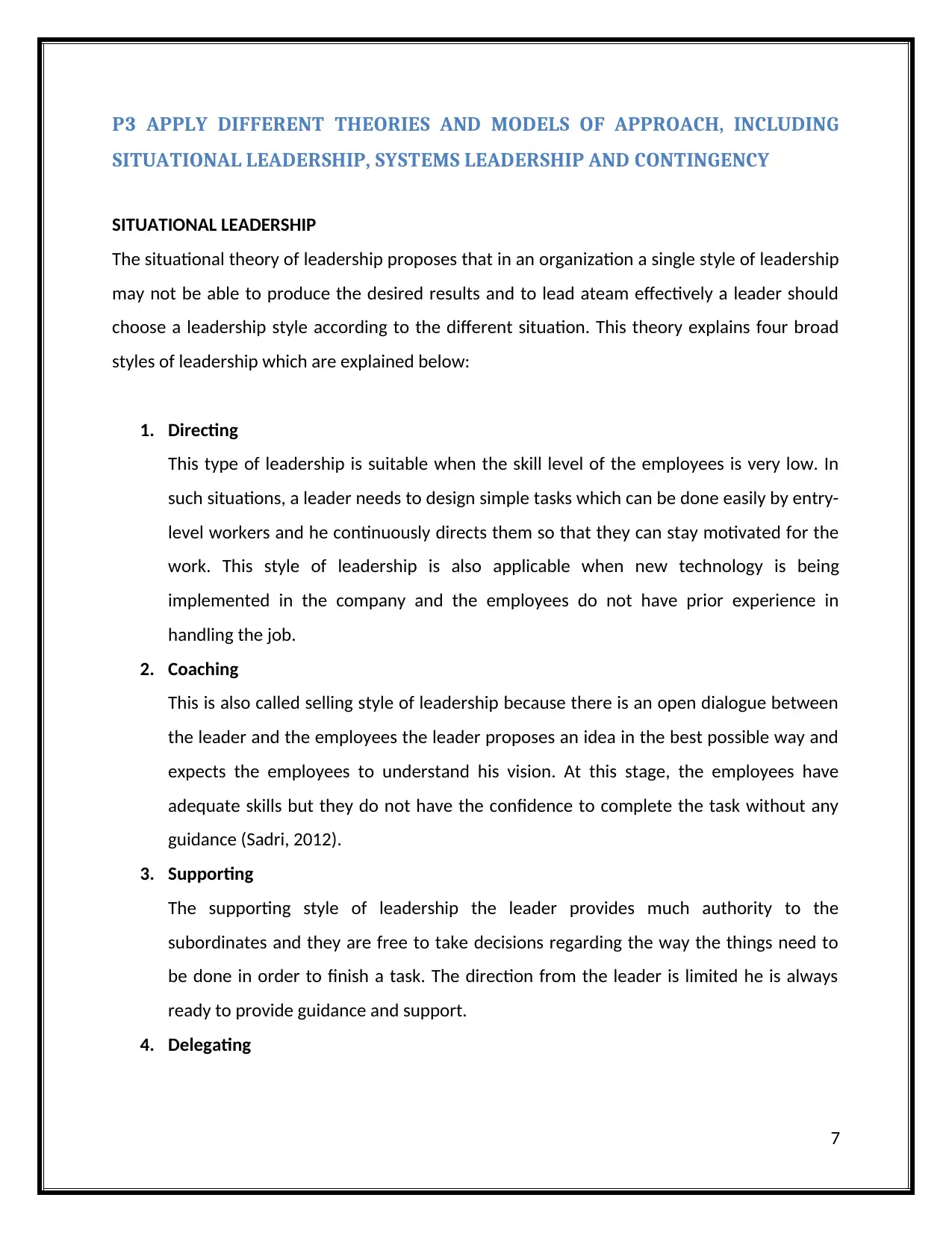
P3 APPLY DIFFERENT THEORIES AND MODELS OF APPROACH, INCLUDING
SITUATIONAL LEADERSHIP, SYSTEMS LEADERSHIP AND CONTINGENCY
SITUATIONAL LEADERSHIP
The situational theory of leadership proposes that in an organization a single style of leadership
may not be able to produce the desired results and to lead ateam effectively a leader should
choose a leadership style according to the different situation. This theory explains four broad
styles of leadership which are explained below:
1. Directing
This type of leadership is suitable when the skill level of the employees is very low. In
such situations, a leader needs to design simple tasks which can be done easily by entry-
level workers and he continuously directs them so that they can stay motivated for the
work. This style of leadership is also applicable when new technology is being
implemented in the company and the employees do not have prior experience in
handling the job.
2. Coaching
This is also called selling style of leadership because there is an open dialogue between
the leader and the employees the leader proposes an idea in the best possible way and
expects the employees to understand his vision. At this stage, the employees have
adequate skills but they do not have the confidence to complete the task without any
guidance (Sadri, 2012).
3. Supporting
The supporting style of leadership the leader provides much authority to the
subordinates and they are free to take decisions regarding the way the things need to
be done in order to finish a task. The direction from the leader is limited he is always
ready to provide guidance and support.
4. Delegating
7
SITUATIONAL LEADERSHIP, SYSTEMS LEADERSHIP AND CONTINGENCY
SITUATIONAL LEADERSHIP
The situational theory of leadership proposes that in an organization a single style of leadership
may not be able to produce the desired results and to lead ateam effectively a leader should
choose a leadership style according to the different situation. This theory explains four broad
styles of leadership which are explained below:
1. Directing
This type of leadership is suitable when the skill level of the employees is very low. In
such situations, a leader needs to design simple tasks which can be done easily by entry-
level workers and he continuously directs them so that they can stay motivated for the
work. This style of leadership is also applicable when new technology is being
implemented in the company and the employees do not have prior experience in
handling the job.
2. Coaching
This is also called selling style of leadership because there is an open dialogue between
the leader and the employees the leader proposes an idea in the best possible way and
expects the employees to understand his vision. At this stage, the employees have
adequate skills but they do not have the confidence to complete the task without any
guidance (Sadri, 2012).
3. Supporting
The supporting style of leadership the leader provides much authority to the
subordinates and they are free to take decisions regarding the way the things need to
be done in order to finish a task. The direction from the leader is limited he is always
ready to provide guidance and support.
4. Delegating
7
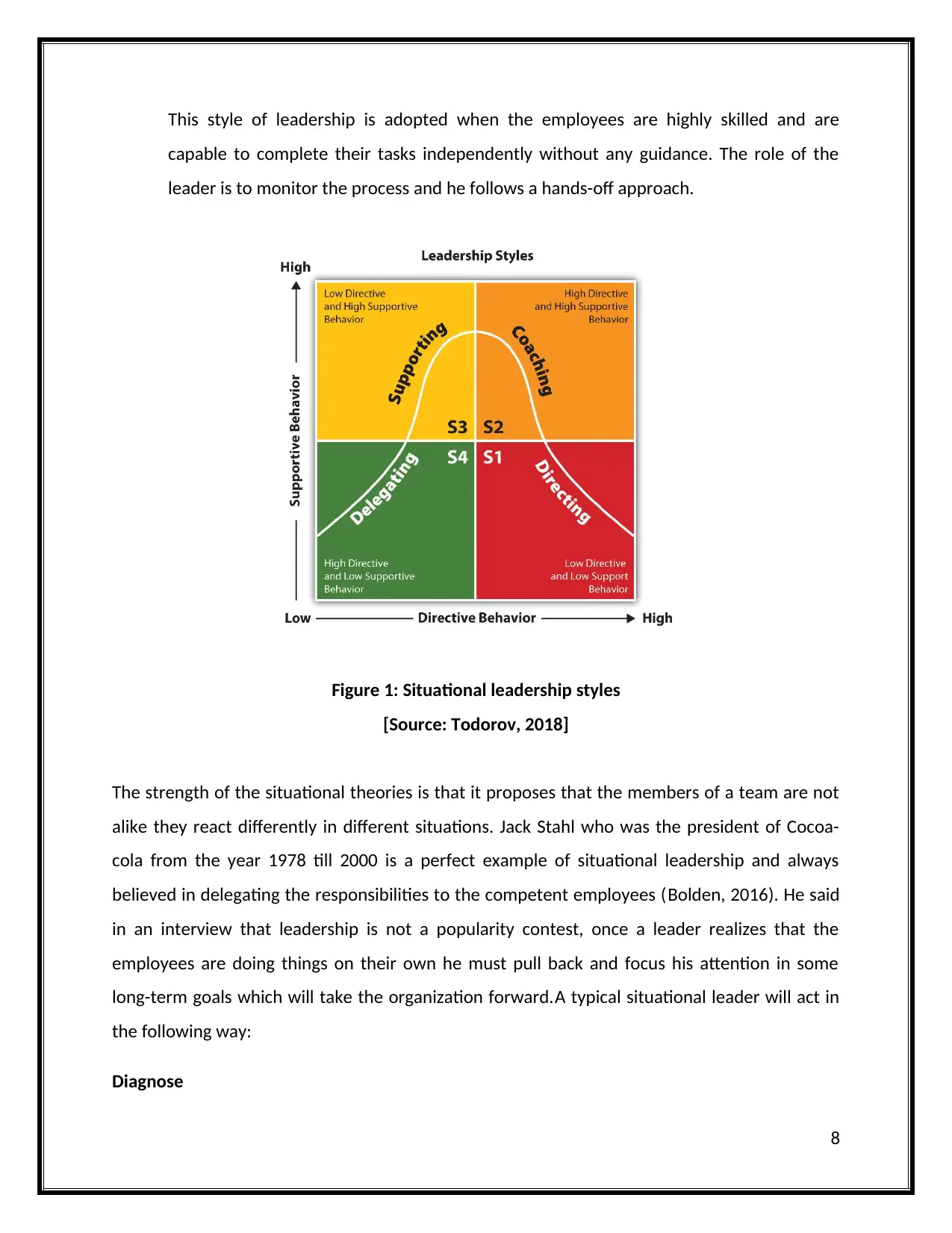
This style of leadership is adopted when the employees are highly skilled and are
capable to complete their tasks independently without any guidance. The role of the
leader is to monitor the process and he follows a hands-off approach.
Figure 1: Situational leadership styles
[Source: Todorov, 2018]
The strength of the situational theories is that it proposes that the members of a team are not
alike they react differently in different situations. Jack Stahl who was the president of Cocoa-
cola from the year 1978 till 2000 is a perfect example of situational leadership and always
believed in delegating the responsibilities to the competent employees (Bolden, 2016). He said
in an interview that leadership is not a popularity contest, once a leader realizes that the
employees are doing things on their own he must pull back and focus his attention in some
long-term goals which will take the organization forward.A typical situational leader will act in
the following way:
Diagnose
8
capable to complete their tasks independently without any guidance. The role of the
leader is to monitor the process and he follows a hands-off approach.
Figure 1: Situational leadership styles
[Source: Todorov, 2018]
The strength of the situational theories is that it proposes that the members of a team are not
alike they react differently in different situations. Jack Stahl who was the president of Cocoa-
cola from the year 1978 till 2000 is a perfect example of situational leadership and always
believed in delegating the responsibilities to the competent employees (Bolden, 2016). He said
in an interview that leadership is not a popularity contest, once a leader realizes that the
employees are doing things on their own he must pull back and focus his attention in some
long-term goals which will take the organization forward.A typical situational leader will act in
the following way:
Diagnose
8
⊘ This is a preview!⊘
Do you want full access?
Subscribe today to unlock all pages.

Trusted by 1+ million students worldwide
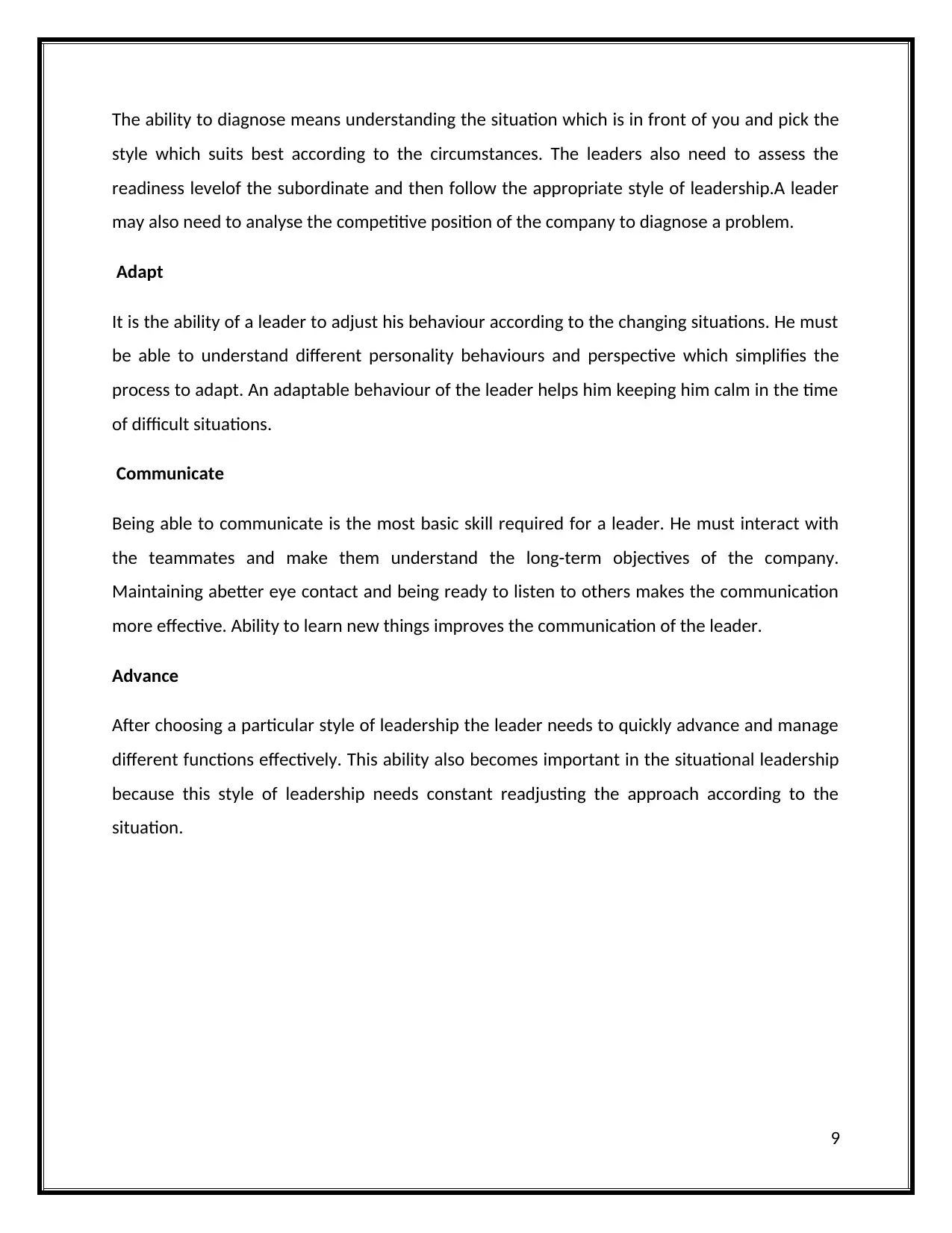
The ability to diagnose means understanding the situation which is in front of you and pick the
style which suits best according to the circumstances. The leaders also need to assess the
readiness levelof the subordinate and then follow the appropriate style of leadership.A leader
may also need to analyse the competitive position of the company to diagnose a problem.
Adapt
It is the ability of a leader to adjust his behaviour according to the changing situations. He must
be able to understand different personality behaviours and perspective which simplifies the
process to adapt. An adaptable behaviour of the leader helps him keeping him calm in the time
of difficult situations.
Communicate
Being able to communicate is the most basic skill required for a leader. He must interact with
the teammates and make them understand the long-term objectives of the company.
Maintaining abetter eye contact and being ready to listen to others makes the communication
more effective. Ability to learn new things improves the communication of the leader.
Advance
After choosing a particular style of leadership the leader needs to quickly advance and manage
different functions effectively. This ability also becomes important in the situational leadership
because this style of leadership needs constant readjusting the approach according to the
situation.
9
style which suits best according to the circumstances. The leaders also need to assess the
readiness levelof the subordinate and then follow the appropriate style of leadership.A leader
may also need to analyse the competitive position of the company to diagnose a problem.
Adapt
It is the ability of a leader to adjust his behaviour according to the changing situations. He must
be able to understand different personality behaviours and perspective which simplifies the
process to adapt. An adaptable behaviour of the leader helps him keeping him calm in the time
of difficult situations.
Communicate
Being able to communicate is the most basic skill required for a leader. He must interact with
the teammates and make them understand the long-term objectives of the company.
Maintaining abetter eye contact and being ready to listen to others makes the communication
more effective. Ability to learn new things improves the communication of the leader.
Advance
After choosing a particular style of leadership the leader needs to quickly advance and manage
different functions effectively. This ability also becomes important in the situational leadership
because this style of leadership needs constant readjusting the approach according to the
situation.
9
Paraphrase This Document
Need a fresh take? Get an instant paraphrase of this document with our AI Paraphraser
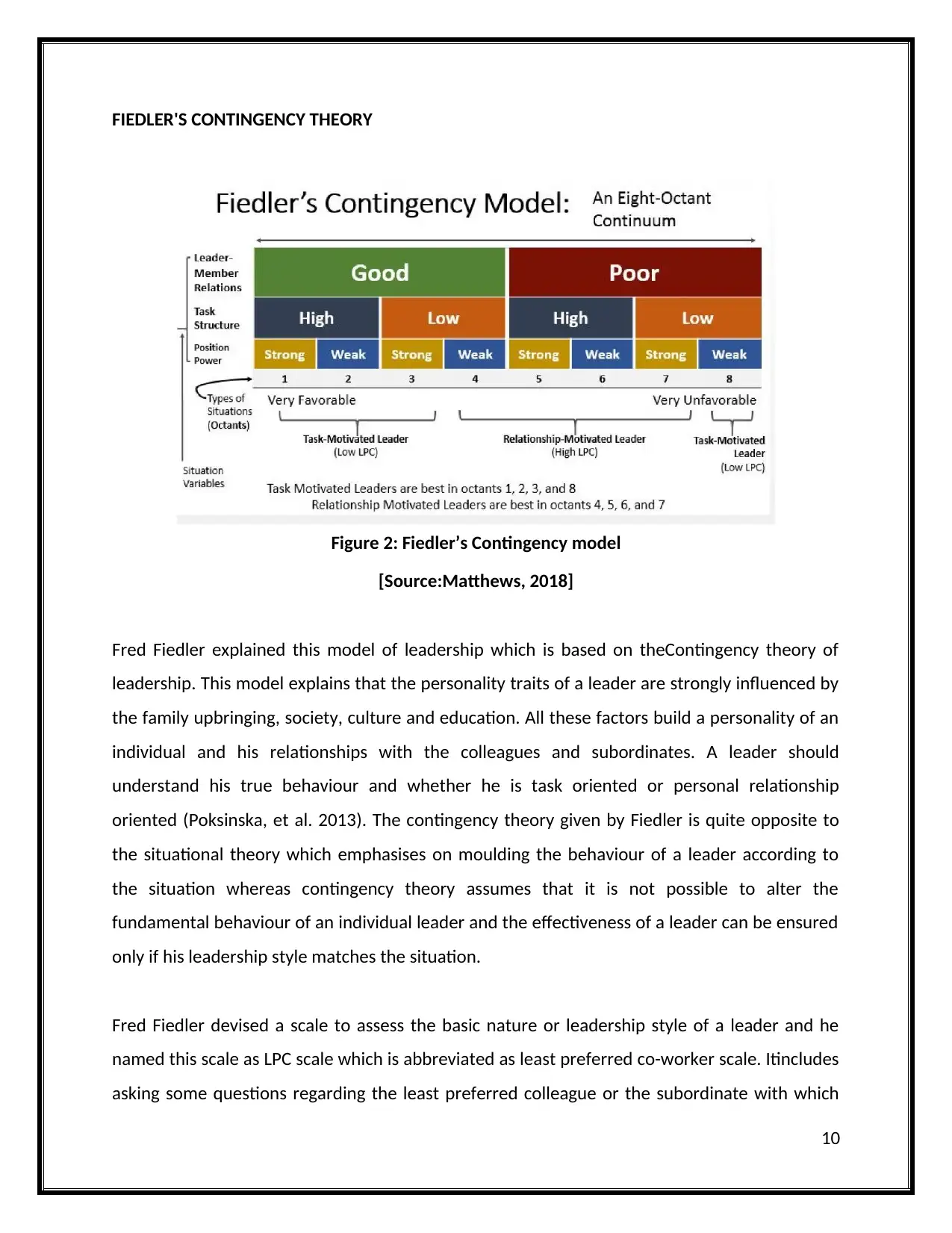
FIEDLER'S CONTINGENCY THEORY
Figure 2: Fiedler’s Contingency model
[Source:Matthews, 2018]
Fred Fiedler explained this model of leadership which is based on theContingency theory of
leadership. This model explains that the personality traits of a leader are strongly influenced by
the family upbringing, society, culture and education. All these factors build a personality of an
individual and his relationships with the colleagues and subordinates. A leader should
understand his true behaviour and whether he is task oriented or personal relationship
oriented (Poksinska, et al. 2013). The contingency theory given by Fiedler is quite opposite to
the situational theory which emphasises on moulding the behaviour of a leader according to
the situation whereas contingency theory assumes that it is not possible to alter the
fundamental behaviour of an individual leader and the effectiveness of a leader can be ensured
only if his leadership style matches the situation.
Fred Fiedler devised a scale to assess the basic nature or leadership style of a leader and he
named this scale as LPC scale which is abbreviated as least preferred co-worker scale. Itincludes
asking some questions regarding the least preferred colleague or the subordinate with which
10
Figure 2: Fiedler’s Contingency model
[Source:Matthews, 2018]
Fred Fiedler explained this model of leadership which is based on theContingency theory of
leadership. This model explains that the personality traits of a leader are strongly influenced by
the family upbringing, society, culture and education. All these factors build a personality of an
individual and his relationships with the colleagues and subordinates. A leader should
understand his true behaviour and whether he is task oriented or personal relationship
oriented (Poksinska, et al. 2013). The contingency theory given by Fiedler is quite opposite to
the situational theory which emphasises on moulding the behaviour of a leader according to
the situation whereas contingency theory assumes that it is not possible to alter the
fundamental behaviour of an individual leader and the effectiveness of a leader can be ensured
only if his leadership style matches the situation.
Fred Fiedler devised a scale to assess the basic nature or leadership style of a leader and he
named this scale as LPC scale which is abbreviated as least preferred co-worker scale. Itincludes
asking some questions regarding the least preferred colleague or the subordinate with which
10
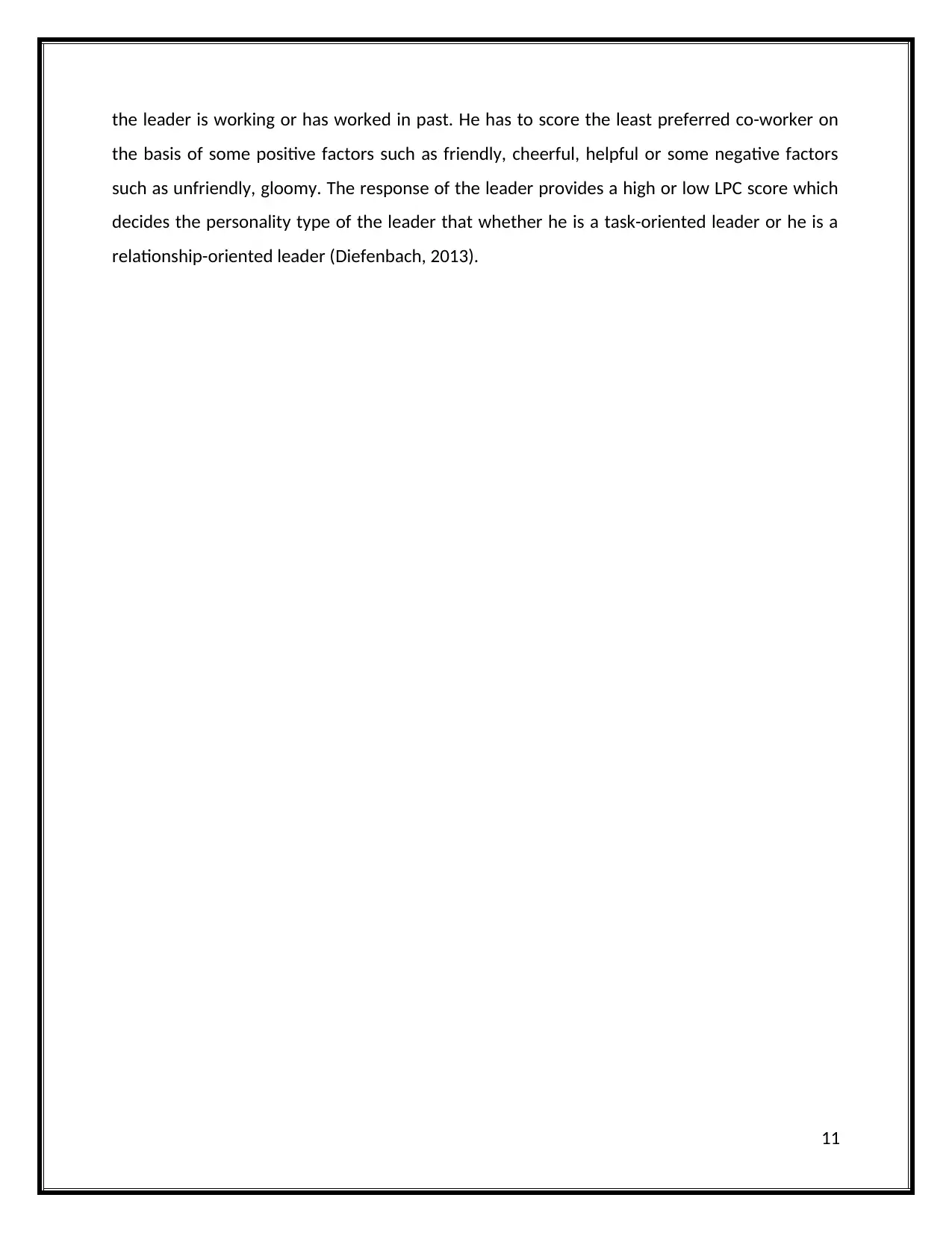
the leader is working or has worked in past. He has to score the least preferred co-worker on
the basis of some positive factors such as friendly, cheerful, helpful or some negative factors
such as unfriendly, gloomy. The response of the leader provides a high or low LPC score which
decides the personality type of the leader that whether he is a task-oriented leader or he is a
relationship-oriented leader (Diefenbach, 2013).
11
the basis of some positive factors such as friendly, cheerful, helpful or some negative factors
such as unfriendly, gloomy. The response of the leader provides a high or low LPC score which
decides the personality type of the leader that whether he is a task-oriented leader or he is a
relationship-oriented leader (Diefenbach, 2013).
11
⊘ This is a preview!⊘
Do you want full access?
Subscribe today to unlock all pages.

Trusted by 1+ million students worldwide
1 out of 23
Related Documents
Your All-in-One AI-Powered Toolkit for Academic Success.
+13062052269
info@desklib.com
Available 24*7 on WhatsApp / Email
![[object Object]](/_next/static/media/star-bottom.7253800d.svg)
Unlock your academic potential
Copyright © 2020–2025 A2Z Services. All Rights Reserved. Developed and managed by ZUCOL.





